Flag Coat of arms | Founded 1348 Date dissolved 1918 | |
 | ||
Religion Roman Catholic,Utraquist, Lutheran,Bohemian Brethren,Moravian Brethren | ||
lands of the bohemian crown every year 1348 1918
The Lands of the Bohemian Crown, often called Czech lands in modern times, were a number of incorporated states in Central Europe during the medieval and early modern periods connected by feudal relations under the joint rule of the Bohemian kings. The crown lands primarily consisted of the Kingdom of Bohemia, an electorate of the Holy Roman Empire according to the Golden Bull of 1356, the Margraviate of Moravia, the Duchies of Silesia, and the Lusatias, as well as other territories throughout its history.
Contents
- lands of the bohemian crown every year 1348 1918
- Name
- History
- Luxembourgs
- Habsburgs
- Other territories
- References
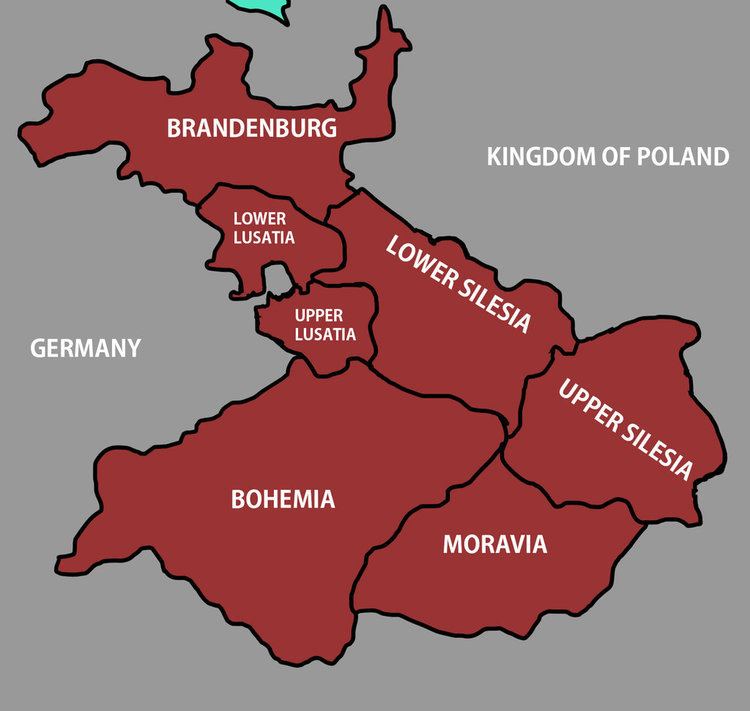
The joint rule of Corona regni Bohemiae was legally established by decree of the Luxembourg king Charles IV issued on 7 April 1348, on the foundation of the original Czech lands ruled by the Přemyslid dynasty until 1306. By linking the territories, the interconnection of crown lands thus no more belonged to a king or a dynasty but to the Bohemian monarchy itself, symbolically personalized by the Crown of Saint Wenceslas. Under the rule of Ferdinand I from 1526, the lands of the Boheman Crown became a constituent part of the Habsburg Monarchy. Later they passed to the Austrian Empire and the Cisleithanian half of Austria-Hungary. By the Czechoslovak declaration of independence in 1918, the remaining Czech lands became part of the First Czechoslovak Republic.

The Bohemian Crown was neither a personal union nor a federation of equal members. Rather, the Kingdom of Bohemia had a higher status than the other incorporated constituent countries. There were only some common state institutions of the Bohemian Crown and they didn't survive the centralization of the Habsburg Monarchy under Empress Maria Theresa in the 18th century. The most important of them was the Bohemian Court Chancellery which was united with the Austrian Chancellery in 1749.
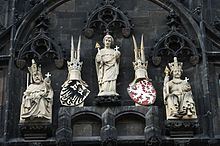
Name
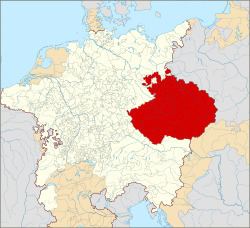
The Lands of the Bohemian Crown (Latin: Corona regni Bohemiae) are called země Koruny české or simply Koruna česká (Crown of Bohemia or Bohemian Crown) and České země (i.e. Czech lands) in Czech language, the adjective český referring to both "Bohemian" and "Czech". The German term Länder der Böhmischen Krone is likewise shortened to Böhmische Krone or Böhmische Kronländer. Native names include Silesian: Korana Czeskigo Krůlestwa, Lower Sorbian: zemje Českeje krony, and Upper Sorbian: kraje Čěskeje Króny. The denotation lands of the Crown of Saint Wenceslas (země Koruny svatováclavské) refers to the Crown of Saint Wenceslas, part of the regalia of the Bohemian monarchs.
History
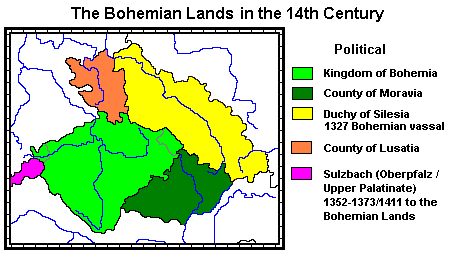
In the 10th and 11th century the Duchy of Bohemia, together with Moravia (margraviate from 1182) and Kłodzko Land were consolidated under the ruling Přemyslid dynasty. Duke Ottokar I gained the hereditary royal title in 1198 from the German (anti-)king Philip of Swabia for his support, whereby his duchy was raised to the Kingdom of Bohemia. The regality was ultimately confirmed by Philip's nephew King Frederick II in the Golden Bull of Sicily issued in 1212.
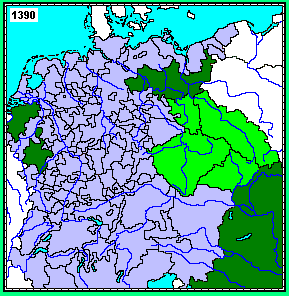
The Přemyslid king Ottokar II of Bohemia acquired the Duchy of Austria in 1251, the Duchy of Styria in 1261, the Egerland in 1266, the Duchy of Carinthia with the March of Carniola and the Windic March in 1269 as well as the March of Friuli in 1272. His plans to turn Bohemia into the leading Imperial State were aborted by his Habsburg rival King Rudolph I of Germany, who seized his acquisitions and finally defeated him in the 1278 Battle on the Marchfeld.
Luxembourgs
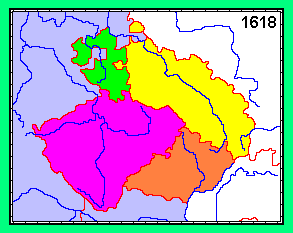
The House of Luxembourg, Bohemian kings upon the extinction of the Přemyslids in 1306, again significantly enlarged the Bohemian lands: King John the Blind vassalized most Polish Piast dukes of Silesia, his suzerainty was acknowledged by the Polish king Casimir III the Great in the 1335 Treaty of Trentschin. He also achieved the enfeoffment with the Upper Lusatian lands of Bautzen (1319) and Görlitz (1329) by the German king Louis IV.
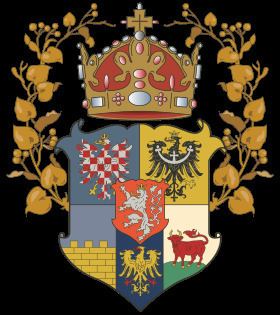
King John's eldest son Charles IV was elected King of the Romans in 1346 and succeeded his father as King of Bohemia in the same year. Charles IV created the Bohemian Crown, together with the incorporated provinces in 1348. The Luxembourg dynasty reached its high point, when Charles was crowned Holy Roman Emperor in 1355. By his Imperial authority he decreed that the united Bohemian lands should endure regardless of dynastic developments, even if the Luxembourgs should die out.
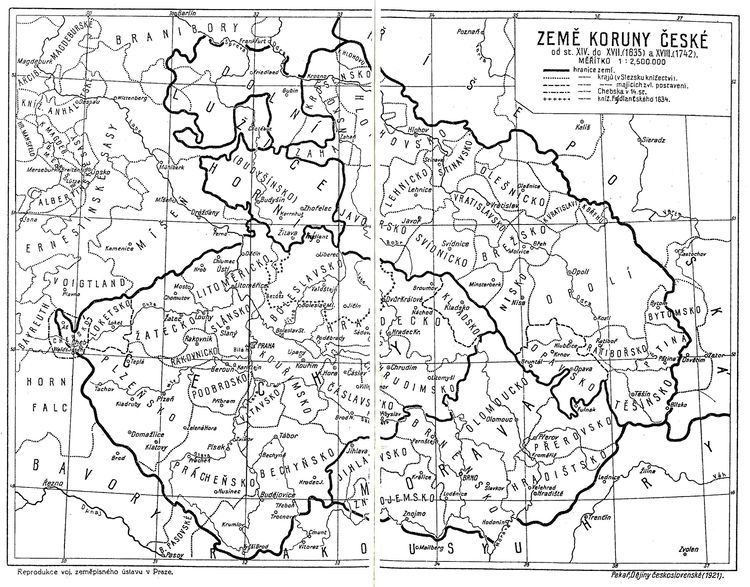
In 1367 he purchased Lower Lusatia from his stepson Margrave Otto V of Brandenburg. Beside their home County of Luxembourg itself, the dynasty held further non-contiguous Imperial fiefs in the Low Countries, such as the duchies of Brabant and Limburg, acquired through marriage by Charles' younger half-brother Wenceslaus of Luxembourg in 1355 as well as the Margraviate of Brandenburg purchased in 1373. As both the King of Bohemia and the Margrave of Brandenburg had been designated Prince-electors in the Golden Bull of 1356, the Luxembourgs held two votes in the electoral college, securing the succession of Charles's son Wenceslaus in 1376.
With King Wenceslaus, the decline of the Luxembourg dynasty began. He himself was deposed as King of the Romans in 1400; Brabant, Limburg (in 1406) and even Luxembourg itself (in 1411) were ceded to the French House of Valois-Burgundy, while Brandenburg passed to the House of Hohenzollern in 1415. Nevertheless, the joint rule of the Bohemian Lands outlived the Hussite Wars and the extinction of the Luxembourg male line upon the death of Emperor Sigismund in 1437.
Vladislas II of the Jagiellon dynasty, son of the Polish king Casimir IV, was designated King of Bohemia in 1471, while the crown lands of Moravia, Silesia and the Lusatias were occupied by rivaling King Matthias Corvinus of Hungary. In 1479 both kings signed the Treaty of Olomouc, whereby the unity of the Bohemian crown lands was officially retained unchanged and the monarchs appointed each other as sole heir. Upon the death of King Matthias in 1490, Vladislas ruled the Bohemian crown lands and the Kingdom of Hungary in personal union.
Habsburgs
When Vladislas' only son Louis was killed at the Battle of Mohács in 1526, a convention of Bohemian nobles elected his brother-in-law, the Habsburg archduke Ferdinand I of Austria, new king of the Bohemian crown lands. Together with the Austrian "hereditary lands" and the Hungarian kingdom they formed the Habsburg Monarchy, which in the following centuries grew out of the Holy Roman Empire into a separate European power. Attempts by the Bohemian Protestant estates to build up an autonomous confederation dashed at the 1620 Battle of White Mountain, whereafter the administration was centralised at Vienna. Moreover, the Habsburg rulers lost the Lusatias to the Electorate of Saxony in the 1635 Peace of Prague and also most of Silesia with Kladsko to King Frederick II of Prussia in the 1742 Treaty of Breslau.
In the modern era, the remaining crown lands of Bohemia, Moravia and Austrian Silesia became constituent parts of the Austrian Empire in 1804 and the Cisleithanian half of Austria-Hungary in 1867. After World War I and the dissolution of the Austro-Hungarian monarchy, these became the historic regions usually referred to as the Czech lands forming the Czech Republic. Austrian Silesia with the Hlučín Region is today known as Czech Silesia, with the exception of eastern Cieszyn Silesia which passed to the Second Polish Republic in 1920.
